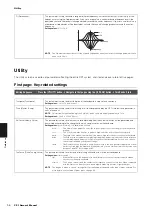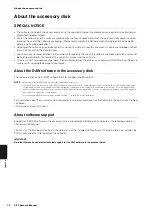
Utility
CP1 Owner’s Manual
57
R
eference
Second page: Tuning system and pedal settings
Third page: Controller settings
Editing Sequence:
Press the [UTILITY] button
Navigate to the second page using the [
L
PAGE] and [PAGE
R
] buttons
Turn Knobs 2 to 6
Scale
This parameter is used to select a musical tuning system. While the Equal Temperament tuning system has
now become standard for pianos, a wide number of other systems were developed over the years before it
was adopted, and these systems invariably paved the way for the birth of new musical styles. By selecting a
different tuning system, you can play tunes from the corresponding styles of music and enjoy their unique
sounds. In total, the CP1 can replicate seven different musical tuning systems.
Setting values:
See the following table
Equal
The range of pitches in each octave is divided equally into twelve parts, with each
half-step evenly spaced in pitch. Today, this is by far the most popular tuning system
for pianos.
Pure Major
Pure Minor
These two tuning systems preserve the pure mathematical intervals of each scale,
especially for triad chords (root, third, fifth). These characteristics are best heard in
vocal harmonies — such as choirs and
a cappella
singing
Pythagorean
This scale was devised by the famous Greek philosopher, Pythagoras, and is created
from a series of perfect fifths, which are collapsed into a single octave. The thirds in
this tuning are not so smooth, but the fourths and fifths are beautiful and suitable for
some leads
MeanTone
This scale was created as an improvement on the Pythagorean scale by making the
major third interval sound smoother. It was especially popular from the latter part of the
16th century to the end of the 18th century, with Handel being one of its most notable
users.
WerckMeister
(Werckmeister)
KirnBerger
(Kirnberger)
The Werckmeister and Kirnberger scales improve the mean-tone and Pythagorean
scales by combining them in different ways. Both are uniquely characterized by the
way in which modulation can change the nuances of individual songs. Often applied in
the era of Bach and Beethoven, they are used today to reproduce the music of that era
on harpsichords.
Basenote
This parameter is used with
Scale
settings other than “Equal” to specify the base note (or root note) of the
song to be played.
Setting values:
C to B
SusPedal (Sustain Pedal)
This parameter is used to indicate the type of foot controller plugged into the [SUSTAIN] foot-switch jack
located on the CP1’s rear panel.
Setting values:
Sustain, FC3(HalfOn), FC3(HalfOff), or FC4/5
Sustain ................ Choose this setting when the right-hand pedal from the pedal unit that came with your
CP1 (i.e., the Sustain pedal) is plugged into the jack. With this setting and pedal, half-
damper playing is supported.
FC3(HalfOn) ........ Choose this setting when using an optional FC3 foot controller for half-damper playing.
FC3(HalfOff) ........ Choose this setting when using an optional FC3 foot controller but not the half-damper
playing technique.
FC4/5................... Choose this setting when using an optional FC4 or FC5 foot controller.
Editing Sequence:
Press the [UTILITY] button
Navigate to the third page using the [
L
PAGE] and [PAGE
R
] buttons
Turn Knobs 1 and 3
Source
This parameter is used to select the controller to be edited.
Setting values:
FC1 (Foot Controller 1), FC2 (Foot Controller 2), FSAssign (assignable foot switch), Soft (Soft
pedal), or Sostnuto (Sostenuto pedal)
FC1/FC2 .............. Foot controllers connected via the [1] and [2] foot-controller jacks.
FSAssign ............. Foot switch connected via the [ASSIGNABLE] foot-switch jack
Soft ...................... Pedal connected via the [SOFT] foot-switch jack
Sostnuto .............. Pedal connected via the [SOSTENUTO] foot-switch jack
ContrlNo (Control Number)
This parameter is used to set a control change number for the controller set using
Source
.
Setting values:
Source
set to “FC1” or “FC2”: 00 (off), or 01 to 95
Source
set to “FSAssign”, “Soft”, or “Sostnuto”: 00 (off), 01 to 95, 99 (PcInc), or 100 (PcDec)






























